6 Best Free Website Builders 2023: The Definitive List
Our independent research projects and impartial reviews are funded in part by affiliate commissions, at no extra cost to our readers. Learn more
During our rigorous research and testing of free website builders, we found that Wix is the best overall. Its free plan comes with a generous number of features and dependable support channels, and it’s well-liked by customers.
GoDaddy takes second place because of its easy-to-use ADI builder, attractive SEO tools, and the speed at which it allows you to get online. And rounding out our top three is Square Online thanks to its free plan that permits selling – a feature that’s usually reserved for premium plans.
You can see the full list below, and discover our expert insights on the top six free website builders:
The 6 Best Free Website Builders
- Wix – Best overall website builder with a wide range of free features
- GoDaddy – Best for getting online quickly for free
- Square Online – Best for selling online for free
- Webflow – Best free plan with limited ads
- Site123 – Best features suited to hobbies and small projects
- Pagecloud – Best for building with custom code
We’ve carried out tons of research and tested hundreds of website builders over the years, so we know what matters when it comes to the best free plans. As we navigate difficult economic climates, free website builders might be a wise option to explore.
We used our independent research to create this list, providing you with accurate and reliable recommendations. It’s no secret that free website builders aren’t the best way to build a website – they often come with various limitations, such as displaying ads on your site or a lack of ecommerce tools, making them less than ideal for long-term growth. But they’re an affordable option to get started with and they give you the freedom to get to grips with the builder before you commit to a paid plan!
To help you make an informed decision, we’ve made sure to include all of the facts in this article – including what each builder does and doesn’t offer.
Compare the Top 6 Free Website Builders
In a rush? Get all of the key information at a glance with our helpful comparison table:
| BEST IN TEST |  |  | |||
| Wix | GoDaddy | Square Online | Webflow | Site123 | Pagecloud |
| Overall Rating 4.8 | Overall Rating 4.2 | Overall Rating 3.7 | Overall Rating 3.4 | Overall Rating 2.8 | Overall Rating 2.5 |
| Cheapest plan | Cheapest plan $9.99 | Cheapest plan $29 | Cheapest plan $14 | Cheapest plan $12.80 | Cheapest plan $20 |
| Value for Money 3.0 | Value for Money 4.1 | Value for Money 4.1 | Value for Money 2.3 | Value for Money 3.4 | Value for Money 2.4 |
| Number of free templates 800+ | Number of free templates 100+ | Number of free templates 50+ | Number of free templates 40+ | Number of free templates 100+ | Number of free templates 50+ |
| Storage space on free plan 500MB | Storage space on free plan Unlimited | Storage space on free plan 500MB | Storage space on free plan 1GB | Storage space on free plan 250MB | Storage space on free plan Unlimited |
| On-site ad on free plan Sticky top banner | On-site ad on free plan Bottom banner | On-site ad on free plan Bottom banner | On-site ad on free plan No ads | On-site ad on free plan Bottom banner | On-site ad on free plan Footer disclaimer |
| SSL security included on free plan | SSL security included on free plan | SSL security included on free plan | SSL security included on free plan | SSL security included on free plan | SSL security included on free plan |
| Free ecommerce features | Free ecommerce features | Free ecommerce features | Free ecommerce features | Free ecommerce features | Free ecommerce features |
Take our free and speedy quiz to find out which website builder is perfect for you:
1. Wix
Best overall website builder with a wide range of free features
Wix is by far the best all-around website builder on the market today.
Wix
Best overall website builder with a variety of free features
- 800+ customizable designs
- Easiest builder to use
- Tons of creative freedom
Free plan available
Paid Plans: $16 - $159 / month
Pros
-
Plenty of features on the free plan
-
250+ apps to add more power to your site
-
Free SEO wizard helps gain more traffic
Cons
-
Free plan ads are very noticeable
-
Can’t switch templates after publishing
-
Cheapest upgrade costs $16/month
Wix: At A Glance
Our top choice for the best free website builder is Wix, scoring an overall 4.8 out of 5 in our research and maintaining its high score from last year’s research. Wix is extremely easy to use, comes packed with features – even on its free plan – and gives you total creative control over your site’s design thanks to its drag-and-drop editor.
Its free plan comes with up to 500MB of storage and bandwidth as well as access to essential features, including SEO tools.
Although Wix’s free domain isn’t the catchiest, you can customize it to reflect your brand. For example, your free domain name could be: www.websitebuilderexpert.wixsite.com/website-builder-expert. This gives Wix an advantage over other builders that give you a domain you can’t edit, such as Site123.
Expert Insights: What We Thought When Using Wix
We used Wix to create a free website for Lucy’s Cupcakes, an imaginary business. The whole building process took about half a day. Wix was easy to use, but still gave us all the creative freedom we needed to make our site look exactly how we envisioned it. We especially like the fact that our template came with the Wix Restaurant app built-in!
What we liked about Wix:
- Customization options – we could drag anything anywhere, making it easy to line things up exactly how we wanted them!
- Template choices & designs – our chosen template already had a menu built-in.
- The undo option – simply hit CTRL + Z to undo changes you’ve made. This is a small but surprisingly useful feature.
- Ease of use – changing text, images, and backgrounds only took a few clicks. Wix even has an image library on hand, which made it even faster!
- Improved SEO features – we noticed a real improvement to Wix’s SEO offering, including a partnership with keyword support tool, Semrush.
- Mobile editor – see how your website looks on mobile devices thanks to Wix’s mobile editor, allowing you to make sure your pages are optimized for every visitor.
What could be improved:
- Onboarding – although Wix is super easy to use, it can feel a little overwhelming when the editor first loads because there are so many options and features to choose from.
- App market – it’s hard to tell which apps are free to use and which apps cost money. We also encountered a lot of loading issues when trying to explore the app market.
- Locked template – you can’t swap your template once your site is live, so make sure you’re really happy with your chosen theme ahead of publishing.
Our Wix demo website: https://carnagelucy.wixsite.com/lucyscupcakes
Wix Gallery
Wix has the highest ease of use score out of all the builders on this list, scoring 4.4 out of 5 thanks to its intuitive and beginner-friendly editor. For some, the overwhelming number of features and level of customization can seem like a lot to wrap your head around when starting out – but Wix is on hand to help you at every stage.
In fact, we’d recommend Wix to anyone looking for a super easy builder to get started with, especially if you’re a total beginner. One of our website testers said:
“It’s really intuitive to use, a beginner would grasp it easily!”
Wix scores an incredibly high 4.6 out of 5 for its design functionalities, making it the strongest option on this list. This is largely thanks to its drag-and-drop editor, ADI builder, and its large range of templates to choose from.
With a selection of more than 800 templates, it’s no surprise that Wix scores a perfect 5 out of 5 for its themes, seeing no change from last year’s score.
Most of the templates are free – and when combined with Wix’s huge choice of tools and elements, like galleries, buttons, and social media icons, Wix makes building a website incredibly easy.
Wix guides you through the setup process – you can choose the type of site you want to create, your industry, and your template before starting to build.
For our demo site, we chose the “Restaurants & Food” industry during setup, which gave us 68 tailored templates to pick from. We chose the “Ice Cream Parlor” template.
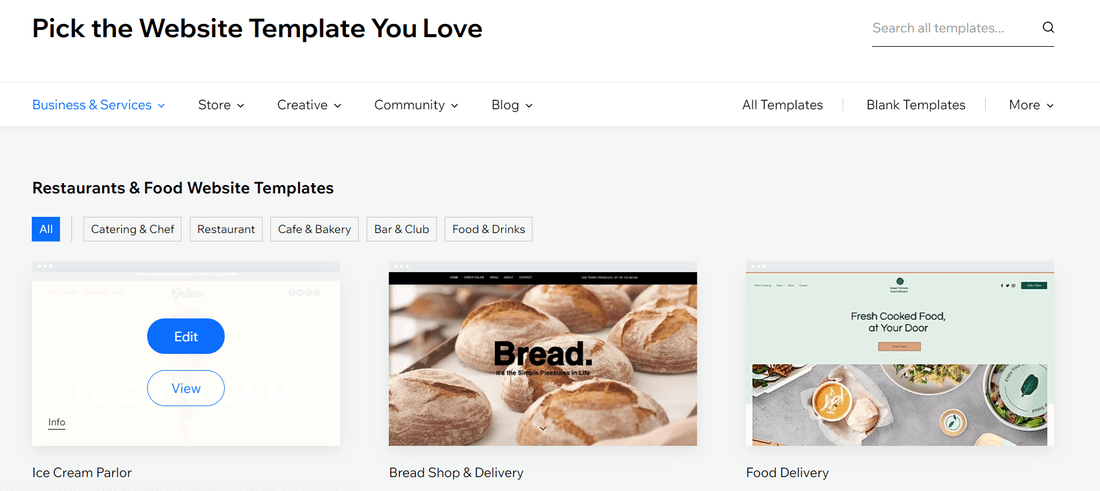
Our chosen template came with the Wix Restaurant feature pre-installed, which made editing the example menu quick and easy.
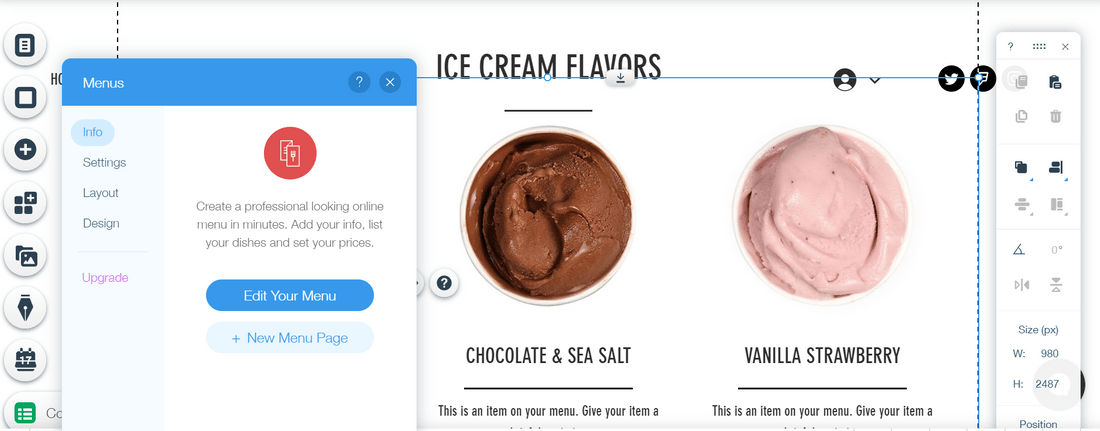
Most Wix templates are available to users of its free plan – including the one we used to create our demo website.
You can’t use a personal domain (a custom website address) with Wix’s free plan – your domain will follow the format yourusername.wixsite.com/yoursite. So instead of lucyscupcakes.com, you’ll be stuck with a much lengthier domain, like this one: carnagelucy.wixsite.com/lucyscupcakes. Quite a mouthful!
Because of this, make sure to choose a professional username as well as a short brand name – you’re restricted to 20 characters for the “yoursite” part of the address.
Wix’s free plan also caps your storage and bandwidth at just 500MB. This will prevent you from using too many images or videos on your site, as well as potentially limiting how many visitors you can receive. And, if you’re looking to sell online, you’re out of luck with Wix’s free plan.
Wix’s premium plans start at $16 per month, billed annually. We know this might seem expensive, but with Wix, you get what you pay for – and that’s a ton of impressive and powerful features. It has the highest features score out of all the builders we tested – a mighty 4.8 out of 5 – and its prices reflect this.
Among other things, Wix’s $16 per month Light plan removes any ads from your site, lets you use a custom domain, and increases your storage to 2GB.
But if you want to start selling online, you’ll need to choose the Core plan (at $27 per month) or one of the other higher plans.
Wix’s free plan includes a banner ad for Wix which stays in place as you scroll down the site. It’s not too in-your-face, and it’s pretty subtle in comparison to other builders, but it’s still intrusive.
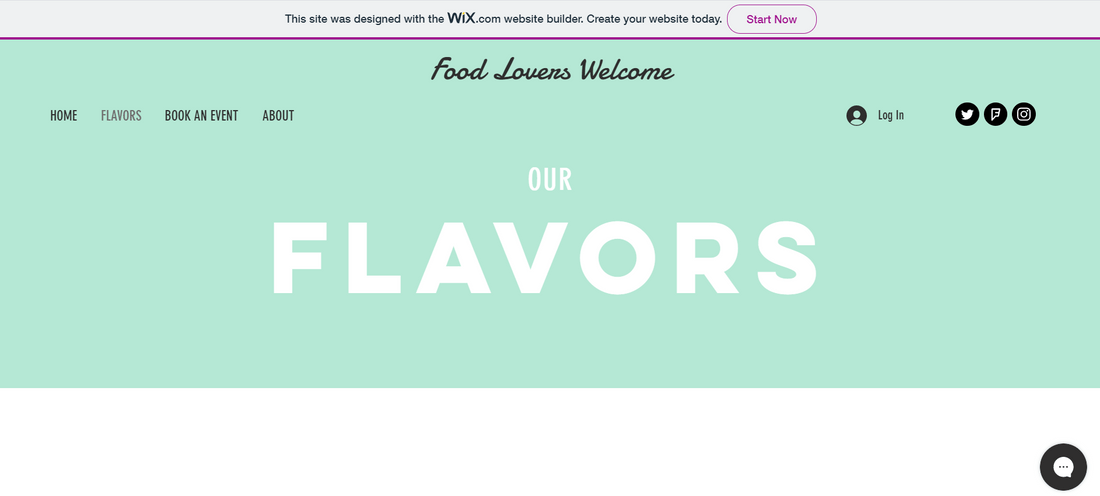
The banner says “This site was designed with the Wix.com website builder. Create your website today.” – this signals to your website visitors that your site isn’t as professional as others. We’d recommend investing in a paid plan to remove the banner when you can.
Although you can start creating a Wix website for free, you’ll need to upgrade if you want your website to take secure payments. To sell products you’ll need to get the $27 per month Core plan. For this price, you’ll be able to sell up to 50,000 products, unlock 50GB of storage space, and sell via your social media channels.
Wix and Intuit Mailchimp have announced a multi-year partnership, meaning Wix website owners will be able to seamlessly sync with Mailchimp’s email marketing suite and learn from insights offered by the platform.
Wix in Action: Easy Aviation Theory
Q&A
When did you start using Wix, and how long did it take to build a website?
Why did you start on the free plan? Have you upgraded your plan since?
What do you like most about Wix?
I also get tax, payment, and cost information through the business account. I paid extra for the business account and this allowed me to increase sales by accepting more payment methods and allowing my customers to trust the site more, having the options for credit card, PayPal, and direct debit.
What would you change about Wix?
Did you feel restricted by the free plan? Were you bothered by any ads?
The ads Wix runs don’t worry me as I used Google Ads to also generate income from the website. It’s just something people have to see or view to get the information off the site.
Were you satisfied with the website you made and would you recommend Wix to others?

More Information
- Wix Review: If you’re looking for more information on Wix, then our detailed review is a great place to start.
- Wix Pricing: We take a closer look at the cost of Wix’s premium plans and what you get for your money.
2. GoDaddy
Best for getting online quickly for free
GoDaddy’s ADI makes it easy to build a website in no time at all.
GoDaddy
Best for getting online quickly for free
- User-friendly with ADI
- Quickest builder to use
- SEO Wiz to help optimize
Free plan available
Paid Plans: $2.99 - $469.99 / month
Pros
-
Plenty of features on the free plan
-
Switch templates when you want
-
Improved site performance
Cons
-
Lack of creative control
-
No mobile editor
-
Upgrade for custom domains
GoDaddy: At A Glance
GoDaddy is ideal for anyone looking to create a clean, basic website in a short period of time. With its decent free plan, GoDaddy secures second place in our list, scoring an overall 4.2 out of 5.
It is quite user-friendly, coming in second for ease of use in our rankings. This is largely thanks to its ADI functionality, which builds your website based on a few answered questions – saving you tons of time and helps to quickly get your site live. But, since the last time we tested the builder, there have been no significant updates to GoDaddy’s design process, meaning its templates don’t stand out too much when compared with its competitors.
With this in mind, we’d recommend GoDaddy for smaller sites and businesses, or anyone looking to build something that is quite simple in nature.
Expert Insights: What We Thought When Using GoDaddy
When we created our demo site with GoDaddy, it was clear that the builder is easy to use. After answering a handful of simple questions, GoDaddy got to work producing a sleek site. There were even customization tools at the bottom, allowing us to to add our personal touch. You get to play around with themes, fonts, color schemes, and CTA buttons.
What we liked about GoDaddy:
- Easy set up – like Wix, GoDaddy asks you what sort of website you want to create and what your business name is, and then gives you custom themes to work with.
- SEO features – by heading over to “Get found by Google” in the Settings, you can start optimizing your website in just a few clicks. No need to soak up any SEO knowledge before building!
- Efficiency – GoDaddy saves you tons of time thanks to its ADI functionality, making it one of the fastest website builders on the market today.
What could be improved:
- Lack of mobile editor – GoDaddy supposedly optimizes your site for mobile devices itself, but it’s a shame you aren’t given greater control over this aspect. You can preview your pages for mobile users but any editing you want to do will have to be using the desktop view, whereas other builders, like Wix, will let you edit the appearance on mobile directly.
- Limits on creativity – when it comes to design elements, you can’t move or resize them too drastically. For example, Wix lets me drag a text box wherever I want it to go, but GoDaddy only lets me adjust its alignment to the left, right, or center. This is especially annoying if you’re trying to make the website layout unique to your brand.
Our GoDaddy demo website: https://lucyscupcakes.godaddysites.com/
GoDaddy Gallery
Seeing no change from last year’s research, GoDaddy maintains its ease of use score of 4.1 out of 5, making it the second easiest free builder after Wix. You won’t need any prior experience to get started with this builder, and its free plan – combined with GoDaddy’s ADI functionality – means your site will be live in a flash.
You have a business contact page available in each free template, but it’s definitely more limited than other website builders in terms of creative freedom. Still, GoDaddy’s ease of use really depends on how unique you want your site to be. If you’re pretty happy to stick with the template’s design, GoDaddy will work in your favor.
For its design functionalities, GoDaddy scores an excellent 4.1 out of 5 – a slight drop of 6% since last year’s research. With so many other builders out there offering impressive templates, it’s tough to stand out!
You get 20+ templates to choose from when building a free website with GoDaddy, scoring 3 out of 5 in our template-specific analysis. Now, this is pretty limited in comparison to Wix’s 800+ templates (most of which are free), but GoDaddy’s selection range is broad in terms of the overall design.
The only downside is that the templates aren’t that personalized to the industry you’ve chosen. For example, with our demo website, Lucy’s Cupcakes, the templates didn’t seem very food-related which is what we were after.
Essentially, you get what you pay for! If you’re going for a free GoDaddy plan, there are quite a few features that you won’t have access to. For example, you’ll have to deal with on-site ads – in this case, GoDaddy slaps a “Powered by GoDaddy” banner in the footer of your website.
Additionally, GoDaddy’s free plan doesn’t come with a custom domain. Instead, it’ll look something like this: https://lucyscupcakes.godaddysites.com/. You also won’t have access to the full suite of customization tools, either.
If you want to get your hands on a custom domain and an ad-free website, you’ll have to upgrade to one of GoDaddy’s premium plans.
GoDaddy’s cheapest plan is its Basic plan which costs $9.99 per month when billed annually. With this plan, you get access to a custom domain, and the ability to send 100 emails per month for your business, along with a bunch of extra features.
If your business is looking to expand, the Premium plan will work in your favor. For $14.99 per month (billed annually), visitors can book online appointments with you, and you’ll have an impressive limit of 25,000 emails per month.
But, if you want to dive into the world of ecommerce, the dedicated Commerce plan is your go-to, setting you back $16.99 per month. It has everything you need – from selling on Facebook and Instagram, to connecting with marketplaces like Amazon and Etsy.
With your free GoDaddy website, you don’t need to worry about pesky GoDaddy banners clogging up your website. The only mentions of GoDaddy in a free website are visible in your URL and at the footer of the page – it simply says “Powered by GoDaddy”. For a free website ad, this is pretty subtle!
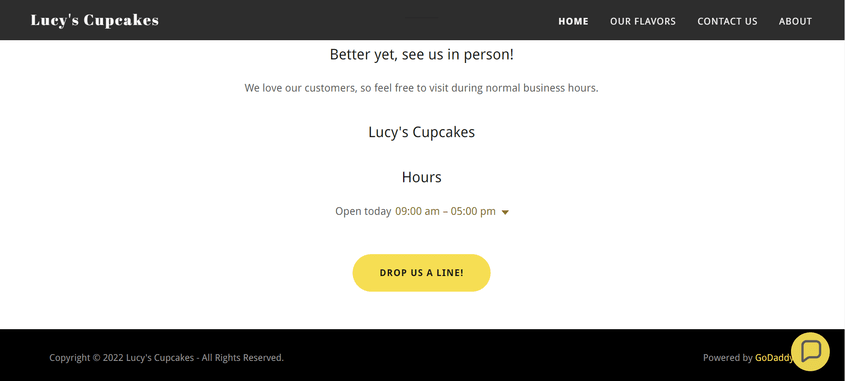
This example shows the website and has a tiny mention of GoDaddy in the bottom corner. In comparison to Wix’s large sticky banner that follows you around as you scroll, this feels less intrusive.
The short answer is no. GoDaddy’s cheapest plan with sales features is its Commerce plan which costs $14.99 per month. It offers basic sales features, allowing you to sell up to 5,000 products. If you need an unlimited product allowance, you’ll need to upgrade to the Commerce Plus plan for $29.99 per month.
To accept payments via GoDaddy, transaction fees across all plans are 2.3% + $0.30.
GoDaddy has teamed up with Paze, an online payments solution, to help improve the customer checkout experience. To access this feature, you’ll need to upgrade to GoDaddy’s Ecommerce plan which starts at $16.99 per month (billed annually).
GoDaddy in Action: ClothingRIC
Q&A
Why did you start with GoDaddy's free plan?
What were you able to achieve with the free plan?
When did you upgrade from the free plan?
How has GoDaddy's paid plan been for you since?

More Information
- GoDaddy Review: Our in-depth look at GoDaddy will tell you everything you need to know about this free website builder.
- GoDaddy Ecommerce Review: Everything you need to know about building an online store in a flash!
- Wix vs GoDaddy: We compare the differences between Wix and GoDaddy to help you decide.
3. Square Online
Best for selling online for free
Square Online’s free website builder is ideal for small businesses since you can sell on its free plan.
Square Online
Best for selling online for free
- Sell online for free
- Speedy set up
- Mediocre templates
Free plan available
Paid Plans: $12 - $79 / month
Pros
-
Good value for money if upgrading
-
Simple to navigate dashboard
-
Unlimited products on free plan
Cons
-
Hard to customize
-
Pay for the best features
-
Weak design options
Square Online: At A Glance
Taking the coveted third spot on our list, Square Online scores an overall 3.7 out of 5 in our recent round of research. What sets Square Online apart from most of the other free website builders on this list is that its free plan allows you to start selling without spending a cent.
Though its editor and design options can feel restrictive, Square Online makes the setup process super quick, meaning you can get your business online as soon as possible. It is because of this that we’d recommend Square Online for small businesses, entrepreneurs, or startups that want to find their footing in the digital market.
Expert Insights: What We Thought When Using Square Online
Our demo website with Square Online didn’t take too long to set up – the onboarding process was fast, and you can get your claws into your site’s design right away. That being said, its editor didn’t feel very user-friendly or intuitive, especially when compared with Wix.
Its section-style editor limits what you can do with your site, and you’ll need to upgrade to a paid plan to unlock advanced design features, such as buttons and icon sets.
What we liked about Square Online:
- The ability to sell – it’s rare to find a free plan that’s suitable for small businesses, and it was very easy to add new products to the website.
- The dashboard – while the editor felt a little clunky at points, Square Online makes navigating between the backend dashboard and your website super smooth.
What could be improved:
- Customization options – Square Online suffers when it comes to design, scoring 2.6 out of 5 in our research, which makes it one of the least customizable builders we’ve tested.
- Help and support – while it does offer phone and live chat support, along with a support center, Square Online doesn’t provide a 24/7 service. If you want help at any time of day, we’d recommend Wix, GoDaddy, or Site123.
Our Square Online demo website: https://lucys-cupcakes.square.site/
Square Online Gallery
Square Online scores an average 3.5 out of 5 for its ease of use in our latest round of research. When building our demo website, we found its editor to be a little frustrating, especially when trying to tweak simple elements like a text box. Without the user-friendly drag-and-drop style editor, Square Online can feel restrictive when compared to Wix.
For some, the limited nature of Square Online won’t work, but for others, it takes away the hassle of creating something stunning. As one of our website testers said:
“It gave you just the right amount of options – it never felt like it was overloading you. This always makes the process easier when you’re not getting overwhelmed with choice.”
Square Online’s approach won’t be right for everyone, and if you do want more creative control, we’d recommend Wix or Webflow.
As we’ve already mentioned, Square Online is one of the worst website builders for design, scoring a low 2.6 out of 5 – putting it just above Site123 and Pagecloud.
What really lets Square Online down is its lack of a drag-and-drop editor, and limited design options when it comes to templates and elements. For example, we weren’t impressed that Square Online puts your site in mobile view to choose a template, and you can’t switch to a desktop view until you’ve made a decision!
Still, if you’re simply after a basic website – especially if you’re a small business – then Square Online could be for you. Instead of creating a beautiful site, Square Online focuses its design attention on highlighting products and information.
Square Online’s free plan comes with a generous amount of features:
- The ability to sell
- SEO tools
- Accept multiple payment types
- Delivery and shipping management
That being said, the free plan does come with a subtle ad and you’ll need to upgrade if you want to connect a custom domain. On Square Online’s free plan, your site’s URL will look like this: https://lucys-cupcakes.square.site/.
If you do decide to upgrade your Square Online plan, you can rest assured knowing that it’s one of the best value for money builders, scoring 4.1 out of 5 and sharing second place with GoDaddy.
After you’ve outgrown its generous free plan, you can choose the Plus plan for $29 per month (billed annually), or the Premium plan for $79 per month (billed annually). This can seem like quite the leap from $0, and it seems considerably more expensive than other starting prices on this list, but you have to remember that these are ecommerce-specific plans.
While Wix’s cheapest plan starts at $16 per month, you’ll need to opt for Wix’s Business Basic plan for $27 per month if you want to start selling – not too different from Square Online.
Square Online’s free plan features an ad, but it doesn’t take up a large chunk of your website. In fact, it’s a small footer on your site that says “Powered by Square”.
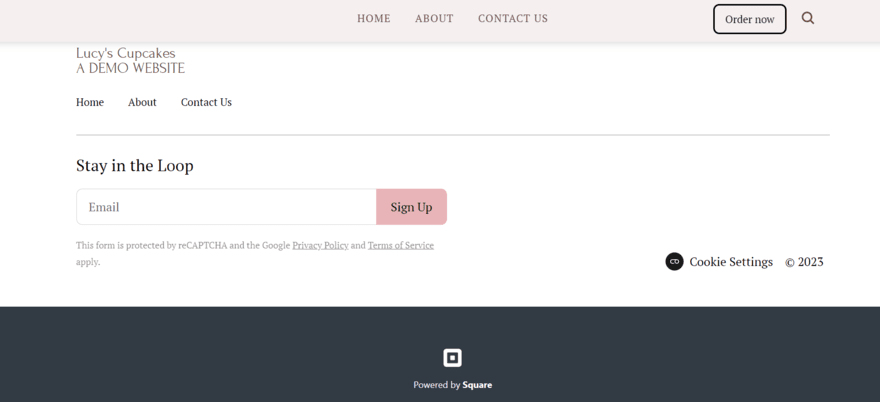
Yes! You can sell with Square Online’s free plan. While you won’t have access to every feature or the best sales tools, it’s a great place to get your business started.
Square Online is arming small businesses with a wave of new features ahead of the holiday season, including 19 new templates, an AI text generator, improvements to inventory and fulfillment management, and retail bundles to group similar products together.
Square Online in Action: Marieke Mertz
Q&A
When did you start using Square Online?
Why did you start on the free plan? Have you upgraded your plan since?
I’ve really enjoyed the free platform, finding it easy to use and set up.
What do you like most about Square Online?
Did you feel restricted by the free plan? Were you bothered by any ads?
Were you satisfied with the website you made, and would you recommend Square Online to others?

More Information
- Square Online Review: Is Square Online the right home for your small business?
4. Webflow
Best free plan with limited ads
Webflow is best suited for web designers and those that can handle large amounts of customization.
Webflow
Best free plan with limited ads
- Advanced customization
- Section block editor
- Industry-specific themes
Free plan available
Paid Plans: $14 / month
Pros
-
Virtual design assistant
-
Ideal for experienced builders
-
No ads on free plan
Cons
-
Overwhelming for beginners
-
No drag-and-drop editor
-
Hardest free builder to use
Webflow: At A Glance
Webflow scores an overall 3.4 out of 5 in our recent research, a score that is largely supported by its impressive design tools. To put it simply, this website builder has web designers in mind, rather than beginners.
Instead of the usual drag-and-drop editor that Wix and GoDaddy offer, Webflow works with padding and section block areas. This format will feel familiar for website owners who are used to large amounts of customization – but for your first website, this could be quite an overwhelming design process.
Expert Insights: What We Thought When Using Webflow
We went ahead and tested Webflow for ourselves with our fake business, Lucy’s Cupcakes. The building process took a couple of hours because of how different it is from the popular drag-and-drop editor. It’s safe to say that without any prior knowledge of using section block areas and overlays, it’ll be a little difficult to navigate at times.
Thankfully, Webflow has a virtual design assistant that gives you an in-depth demo of how everything works before leaving you to it!
What we liked about Webflow:
- Template choice and designs – Webflow makes it clear which templates are best for which industries, offering users a pretty wide selection of free templates (when compared with other builders).
- Creative freedom – Webflow gives a lot of creative control to users and its free plan comes with an array of customizable features.
- Efficient navigation – Webflow relies on the use of short keys and right-clicking to remove or add elements, which streamlines the whole design process.
What could be improved:
- Ability to drag elements – although Webflow is designed with web designers in mind, it would be useful to include a drag-and-drop editor functionality to make it beginner-friendly! We’ve seen how well this works with Wix because the feature really improves the user experience.
Our Webflow demo website: https://lucys-cupcakes-e53b96.webflow.io/
Webflow Gallery
If you’re not familiar with section block areas and overlays, you may find Webflow a little tricky to get your head around! For that reason, it receives an ease of use score of 2.1 out of 5 – making Webflow the hardest builder to use on the list.
Webflow relies pretty heavily on the use of short keys and right-clicking to remove or add elements. While this makes the design process very efficient, it’s not ideal for beginners and there’s little onboarding to help you get started. We’d recommend Webflow for someone that has prior knowledge of padding functionality and won’t too feel overwhelmed with large amounts of customization.
In comparison to its low ease of use score, Webflow scores a great 4.6 out of 5 for its design flexibility.
With both free and premium templates, Webflow covers a wide range of industries, scoring 5 out of 5 for its template offering – putting it on par with Wix. Webflow does a good job of identifying which templates are going to be best for your individual requirements.
That being said, there’s no actual search functionality that limits the number of templates you can browse at once.
Unless you upgrade to Webflow’s premium plans, you won’t have access to a custom domain name or advanced design tools. Paid plans start at $14 per month, billed annually.
Your domain name will also look something like this: lucyscupcakes.webflow.io. A bit clunky!
Webflow offers two types of paid plans: General and Ecommerce plans.
Of the “General” paid plans, there are four to choose from. When billed annually, the Basic plan costs $14 per month, the CMS plan costs $23 per month, the Business plan costs $39 per month, and the Enterprise plan is custom-built to suit your business.
We’d recommend these plans for content-driven websites or blogs because it gives you creative freedom but doesn’t permit too much traffic.
As for Webflow’s “Ecommerce” plans, there are three options. When billed annually, the Standard plan costs $29 per month, the Plus plan costs $74 per month, and the Advanced plan costs $212 per month.
Like most of the builders on this list, the free plan is a great place to start – but you’ll unlock powerful features and tools if you opt for a paid plan.
One great thing about Webflow is that there are no ads on its free plan – you’ll only have “Powered by Webflow” at the very bottom of the page in small writing.
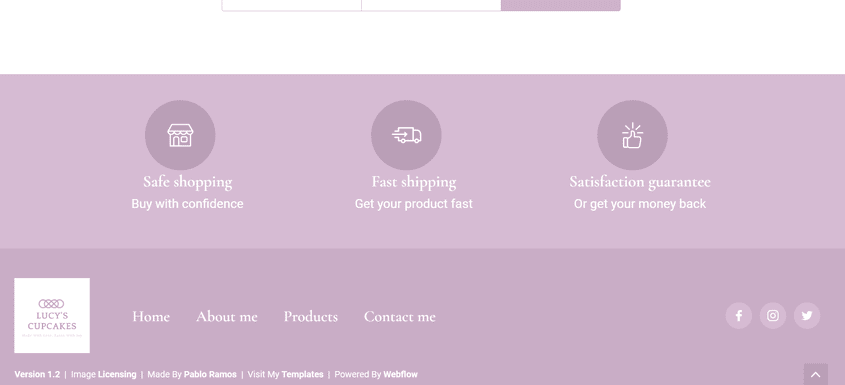
No, you can’t sell for free with Webflow. You can start an ecommerce store by integrating certain apps that help you sell your products, but the apps will cost money and they vary in transaction fees too.
Webflow unveiled a new brand look and exciting new features during the Webflow Conference 2023. The key updates include integration with Spline to create interactive 3D experiences, improved localization capabilities, additional apps, and greater control over design.
Webflow in Action: The Rebel Kulture
Q&A
When did you start using Webflow, and how long did it take you to build a website?
It took me about two weeks of learning and iterating to launch my site (The Rebel Kulture) on Webflow’s free plan. I chose to start there to get familiar with Webflow’s tools before committing to a paid subscription.
Why did you start on the free plan? Have you upgraded your plan since?
After getting the hang of it, I upgraded to add more pages and remove Webflow branding. I now have a custom domain and access to advanced SEO and CMS features.
What do you like most about Webflow?
Were you satisfied with the website you made, and would you recommend Webflow to others?

More Information
- Webflow Review: Learn more about this highly-customizable website builder.
- Webflow vs Squarespace: See how these two design-focused platforms compare to one another.
5. Site123
Best features suited to hobbies and small projects
Site123 is a simple builder, ideal for personal websites and hobbyists.
Site123
Best features suited to hobbies and small projects
- Uses ADI to build sites
- Bountiful app market
- Basic website features
Free plan available
Paid Plans: $12.8 - $97.5 / month
Pros
-
24/7 live chat support
-
Get online quickly
-
No ads visible when page first loads
Cons
-
Unprofessional, non-customizable domain
-
Outdated template designs
-
Extremely limited creative control
Site123: At A Glance
Site123 is ideal for beginners who want to create a nice, simple website – ideally something personal rather than professional. Thanks to its ADI builder, Site123 is super easy to set up, but it won’t be the right fit for you if you’re looking to get creative and push the boundaries of your site’s design.
It’s very limited, scoring an overall 2.8 out of 5 in our recent round of research – a 16% drop since last year’s research. This puts Site123 miles behind our top three free website builder choices.
Expert Insights: What We Thought When Using Site123
The main thing we noticed about Site123 was the design assistance it offers while you build. From creating your basic site for you to providing font pairings and complementary color suggestions, it helps guide you from start to finish. That being said, you aren’t given that much control over your site’s design!
What we liked about Site123:
- How friendly it was – if you have zero tech skills and want a fairly hands-off building experience, Site123 is a perfect choice.
- 24/7 chat support – Site123’s live chat is there to help throughout the building process, which is great if you get stuck.
- Building support – simply choose your industry and site name, and Site123 takes care of the rest for you. It builds you a basic site, and even offers font and color suggestions!
What could be improved:
- The quality of design – it’s no secret that Site123 provides limited creative freedom, scoring 1.9 out of 5 in our design research. This would be less frustrating if the designs were stylish and modern, but they’re very outdated. Our Lucy’s Cupcakes site was easy to build, but the result looked old and bland, especially when compared to the site we made using Wix.
- The free domain – the domain you get with your free Site123 plan is a jumble of letters and numbers, and you’re unable to customize it. This makes your site look incredibly unprofessional. To avoid this, we’d recommend Wix’s free plan instead since it lets you edit the name.
- Basic website features – Site123 offers very simple website features (such as sitemaps and an AI text generator) and limited storage (250 MB) with its free plan. While you get additional features such as statistics and plugins, as well as extra power (up to 100 GB) on the paid plans, it still feels like the bare minimum.
Our Site123 demo website: https://5f35237f568e3.site123.me/
SITE123 Gallery
One thing that makes Site123 so user-friendly is its design-assisted technology. It scores 3.2 out of 5 in our ease of use research category. All you have to do is choose your industry from the 16 options provided, enter your website name, and Site123 does the rest. It creates a basic site for you that you can then customize.
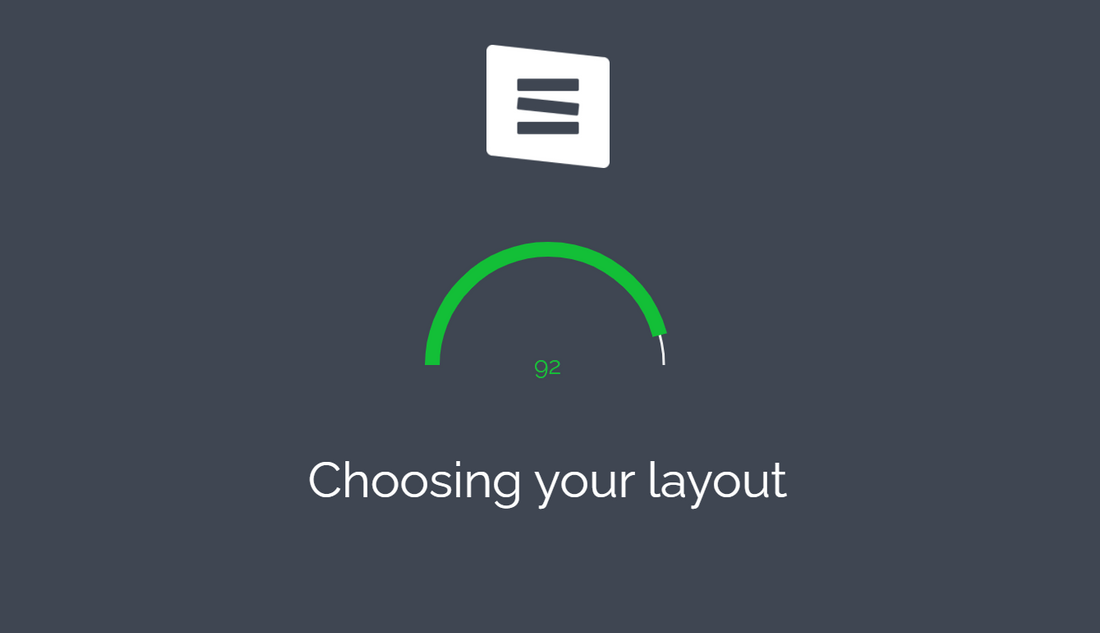
When customizing, you don’t need to know any code – Site123 is suitable for beginners with zero building experience.
As one of our website testers said:
“It’s good for people with no design experience who want a website up and running quickly.”
While it’s helpful that Site123 offers to build your site for you, its design options are incredibly limited. Scoring 1.9 out of 5 in our design research category, Site123 is let down by the basic and outdated templates on offer, as well as the lack of creative control it gives to users.
Its free website templates can be browsed by industry, and with over 100 options including “CV” and “Restaurant”, we awarded Site123’s template choice a score of 3 out of 5.
If you’d rather Site123’s ADI handle the design portion of website building for you, you can simply select the style you want and tweak it if necessary. Despite this, Site123’s customization options aren’t the most exciting or attractive – with the lowest design score of all the builders on this list, we don’t recommend Site123 if you want a stunning website.
Not being able to connect a custom domain is a common drawback with free website builders, but with Site123, it’s a big problem. That’s because Site123’s free domain is a randomly generated jumble of letters and numbers – and you can’t customize it.
The result is an unprofessional, impossible-to-remember domain that looks like this: 5f35237f568e3.site123.me.
This isn’t ideal for businesses or people looking to promote a service to potential customers, especially since the domain doesn’t even show the name of your website. For this reason, we’d recommend Site123 for personal or hobby sites.
When you first view Site123’s plans on its website, you’ll see two options: its free plan, and a premium plan that costs $12.80 per month, billed annually.
However, once you’ve created a free account, you’ll discover a wide range of plans. When billed annually, the plans are priced as follows:
- Basic plan costs $12.80 per month
- Advanced plan costs $19.80 per month
- Professional plan costs $28.80 per month
- Gold plan costs $34.80 per month
- Platinum plan costs $75 per month
While the cheapest paid plan, Basic, removes floating ads from your site, it doesn’t remove them all. So if you want a totally ad-free site, you’ll need to upgrade to the Advanced plan for $19.80 per month.
It’s also worth noting that Site123 often has a sale running, so make sure you check for discounts if you do decide to upgrade.
Site123 has a bottom banner ad that says “I built my site using Site123” and it remains visible as you scroll and navigate other pages.
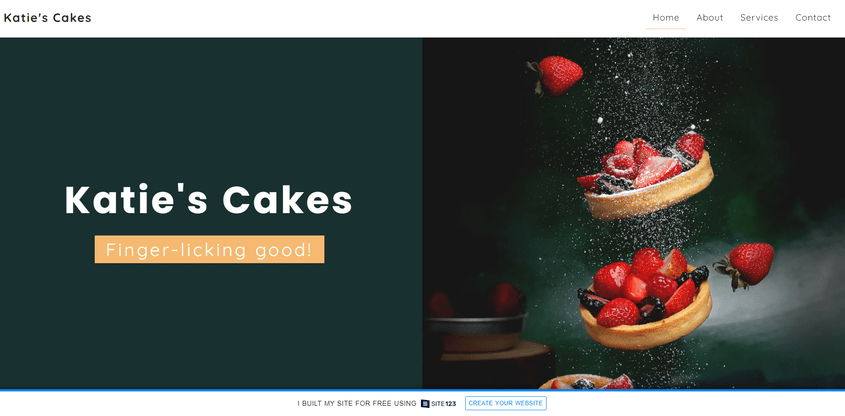
Depending on the style of your site, the ad can be pretty subtle because it’ll blend into the bottom of your page design neatly.
No, you’ll need to upgrade to one of Site123’s premium plans to store and sell products. You can create a website and online store for free, but if you want to sell, you’ll need the Basic plan which costs $12.80 per month. This plan will also allow you to connect a better domain than the mess of letters and numbers Site123 offers on its free plan.
Site123 provides a large suite of blogging features, including an impressive comments system (for replies, monitoring, or automating the process), scheduling tools, and an RSS feed.
Site123 in Action: Yuval Eizik
Q&A
How long have you been using Site123?
Why did you start on the free plan?
What were you able to achieve on the free plan?
When did you upgrade from the free plan and why?
What do you like most about Site123?
Is there anything you'd change about it?
Would you recommend Site123, and why?
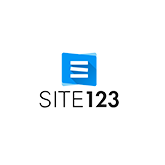
More Information
- Site123 Review: Our detailed review tells you all you need to know about this free website builder.
6. Pagecloud
Best for building with custom code
Pagecloud’s free website builder is more suitable for people with technical experience.
Pagecloud
Best for building with custom code
- Not ideal for beginners
- Lots of customization
- Drag-and-drop editor
Free plan available
Paid Plans: $20 / month
Pros
-
Unique website elements
-
Build with other people
Cons
-
No autosave feature
-
Difficult to navigate
Pagecloud: At A Glance
Completing our list of the top six free website builders is Pagecloud, scoring an overall 2.5 out of 5. While it’s still impressive enough to make our final list, Pagecloud is let down in almost every research category, particularly when it comes to ease of use.
Users looking for a free website builder are typically beginners or are building their very first website, and Pagecloud has a steeper learning curve than most.
Expert Insights: What We Thought When Using Pagecloud
When building our demo website with Pagecloud, the editor and dashboard were fairly easy to navigate but it didn’t feel as intuitive or user-friendly as other builders, such as Wix. In fact, we faced a lot of slow loading times when editing and some steps felt unnecessarily complicated. For example, you can edit text directly on the page, but editing an image opens up a separate menu.
We were also disappointed to find out that Pagecloud’s free plan only allows you to publish one page. If you want additional pages, you’ll need to upgrade to a premium plan.
What we liked about Pagecloud:
- Customization – Pagecloud gives you a ton of creative freedom thanks to its detailed editor. If you have the time to figure it all out, you can build something wonderful.
- Drag-and-drop editor – the familiar drag-and-drop style makes it easy to format the pages to your liking.
- Icons and buttons – we really love Pagecloud’s library of icons and buttons to add to your website, which is something we haven’t seen from other builders.
What could be improved:
- Autosave feature – without an automatic save function, it’s incredibly easy to accidentally lose any progress.
- Site speed – when building our demo site, the editor took a while to load and it even crashed our browser at one point.
Our Pagecloud demo website: https://lucys-cupcakes.mypagecloud.com/
Pagecloud Gallery
The usability of Pagecloud really depends on your experience with website builders. Based on our research, Pagecloud scores 2.7 out of 5 for ease of use – it’s not an ideal starting point for most beginners.
We appreciate its drag-and-drop functionality, but Pagecloud’s overall editor contains a lot to wrap your head around. Not only does it list a number of features on the left-hand side of the editor, but whenever you click on an element, an additional pop-up toolbar appears for more detailed edits.
Plus, without an autosave feature, it’s painfully easy to lose changes you’ve made to your website.
As one person involved in our user testing said:
“I hated that there was no autosave. One of the reasons my template didn’t look too different by the end is because I made changes that I then lost because I forgot to save.”
Unfortunately for Pagecloud, its design options aren’t stellar, scoring 2.2 out of 5 in our recent round of research. When onboarding, Pagecloud asks you about your site’s purpose, but you’re then presented with pretty generic templates to choose from. As a result, Pagecloud’s template score is an equally low 2 out of 5.
One thing we did appreciate about Pagecloud that’s pretty unique is that multiple people can access and edit your site if you grant them permission, meaning you can share the task of designing a website with those you trust. If you don’t want to design the site yourself, give it to someone else!
Pagecloud’s free plan – referred to as Pagecloud Start – has its limitations. To begin, you’re restricted to publishing one page so if you don’t want to upgrade, you’ll need to squeeze all of your information on a single page.
You also can’t add the following features on the free plan:
- A blog
- Team members for editing and management
- Custom domain
- Redirects
- Ecommerce tools
Without a custom domain, Pagecloud’s free plan will present your site like this: https://lucys-cupcakes.mypagecloud.com/.
When you’re ready to upgrade, Pagecloud’s plans are pretty expensive and a long way away from other competitors, such as GoDaddy’s $9.99 per month starting plan.
There are three website builder plans to choose from:
- Small Business costs $20 per month (billed annually)
- Business costs $36 per month (billed annually)
- Pro costs $79 per month (billed annually)
If you’re looking to sell online, Pagecloud offers three ecommerce plans. When billed annually, the Starter plan costs $29 per month, the Advanced plan costs $59 per month, and the Unlimited plan costs $89 per month.
A small “Made in Pagecloud” ad will feature on your free Pagecloud website, hovering in the bottom left corner. Nothing too intrusive!
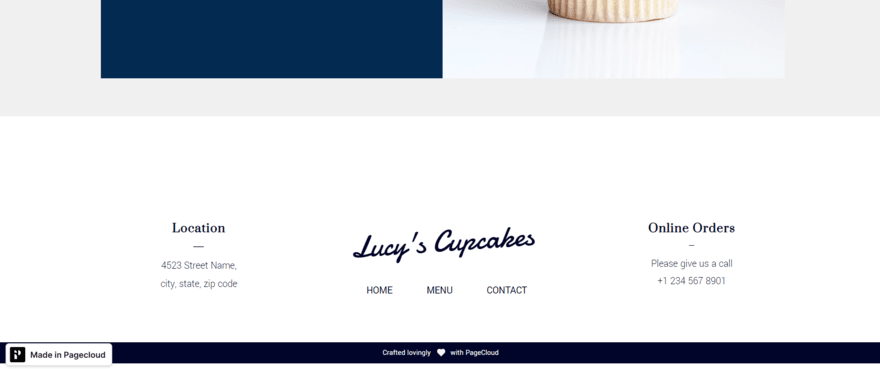
You can’t sell for free with Pagecloud’s free website builder. Its website features are pretty limited, and you’ll need to upgrade to one of Pagecloud’s three ecommerce plans if you want to sell online. These plans start from $29 per month, billed annually.
This month, we’re highlighting Pagecloud’s design animations. If you want to elevate your website content and make the experience more interactive, you can easily animate sections and elements to fade away, zoom in, or even start bouncing around. We recommend playing around with the animations on offer to see what works for your website and brand.

More Information
- Pagecloud Review: Read all about Pagecloud in our full review.
What’s Important in a Free Website Builder?
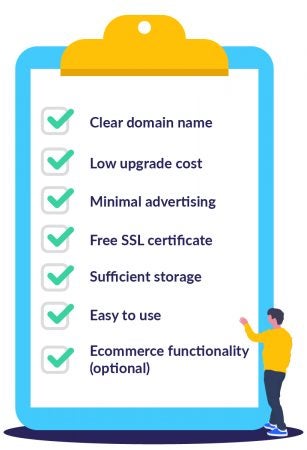 Free website builders might seem too good to be true, but we’re here to demonstrate why this isn’t always the case.
Free website builders might seem too good to be true, but we’re here to demonstrate why this isn’t always the case.
A question we often get asked is: how do these free website builders make their money? Is there something sketchy going on? Luckily, it’s all super safe and above board. These website builders operate on what’s known as a “freemium” business model, whereby the customers who want to pay for extra features effectively fund those who are happy with a limited plan – no strings attached.
That said, there are some elements that you should pay close attention to when deciding on which free website builder to choose.
To create this ranking of the best free website builders, we drew upon our extensive research and user testing for each website builder as a whole. We then combined this with a specific focus on their free plans, investigating whether or not the builder ticked these boxes:
Clear Domain Name
Free website builders won’t let you link up a custom domain name, but what does the auto-generated one look like? For example, a format like Site 123’s domain (https://5f35237f568e3.site123.me/) could make your site look quite unprofessional.
Low Upgrade Cost
Upgrading to a paid plan comes with clear benefits, so it’s good to know how much this would cost.
Minimal Advertising
You don’t need us to tell you that a website plastered with ads won’t look as good as one without them! Our screenshots should help you evaluate the ads of each website builder, helping you to decide on the least intrusive option.
Free SSL Certificate
Most website builders include a free SSL certificate as standard, but a couple of them don’t. Without an SSL certificate, your website will display as “Not secure” to visitors. You can buy an SSL certificate separately for around $10 per year.
Sufficient Storage
Most free website builders have a cap on the amount of content you can upload to your site. If you know you want to include lots of images or videos, be mindful of how quickly you’ll reach this limit.
Easy to Use
There’s no point in finding a website builder that ticks the boxes above only to discover it’s clunky and frustrating to use. We’ve given an indication of how easy each website builder is to use, based on our research and user testing.
Ecommerce Functionality (Optional)
If you need to sell through your free website builder, this limits your options a little. Keep an eye out for website builders we’ve flagged as allowing you to sell on a free plan, like Square Online.
How Do I Create A Free Website? (Step-by-Step)
One thing all the website builders in our ranking have in common – in addition to being free – is that they are easy to set up. The process and learning curve differ slightly from builder to builder, but here are the steps you can expect:
- Sign up with the website builder. This will require an email address, password, and possibly a username. You won’t be asked to insert your card details for any of these six website builders until you’re ready to upgrade your plan.
- Choose a template or answer the design assistant’s questions. This is the first fork in the road – most builders will let you select a template to work off at this stage, but some will use design assistance to mock up a website for you based on your answers to a few questions. We’ve specified when this is the case.
- Add in your own content. Get rid of placeholder text and images, and replace these with your own.
- Tweak and customize your design. If you want to, you can further customize your design by testing out new layouts and colors – even switch to a new template. Most builders let you switch templates after publishing, but keep in mind that Wix doesn’t.
- Press publish! At this point, your domain name will be generated, and your site will be live for the world to see.
This process could take anything from 15 minutes to a few hours, depending on how much you switch up in steps three and four.
Is It Worth Upgrading to a Paid Plan?
As we’ve seen, free website builders can do a lot, but paid plans allow for a lot more. Paid doesn’t have to mean expensive – you can take advantage of premium features for as little as $9 per month.
The most common advantages of paid plans include:
Removing Ads
When you’re trying to achieve a professional image, it’s better to have no ads instead of subtle ads – and upgrading your plan will leave your site ad-free.
Connecting a Custom Domain Name
Again, yoursite.com is a whole lot better than yoursite.yourwebsitebuilder.com, and a whole lot more memorable, too.
Access to More Storage and Bandwidth
As your site grows and your traffic increases, you might outgrow your free plan. You may need to upgrade to increase your storage or make your website accessible to more people. Many paid plans offer unlimited storage and bandwidth, so you can have total peace of mind.
Ability to Sell
Most free website builders won’t let you unlock ecommerce capabilities until you’ve upgraded to a premium plan– apart from Square Online, which does let you sell on its free plan. If you have a small business or want to sell products and services to customers, you won’t be comfortable with a free plan for long.
Advanced Website Features
The features and tools needed to take your business or hobby to the next level will often be waiting for you in a premium plan, so make sure you take a look!
While there’s no pressure to upgrade to a paid plan at any stage, we think it’s always worth checking out or trialing a plan at some point. We know it can be nerve-wracking to invest money in a new business, project, or hobby, but there’s an element of “fake it till you make it” here. With the added professionalism of a paid site, nobody needs to know that you’re not far more established.
Our Testing Methodology
At Website Builder Expert, we pride ourselves on sharing data-led recommendations with our readers. To bring you the best free website builders on the market, our in-house research team has put over 50 builders through our expert research process. To review and compare the builders fairly, we investigate important areas such as:
- Website features
- Design flexibility
- Value for money
- Help and support
- Customer satisfaction
- Ease of use
Within each of these categories, we focus on specific sub-criteria to assess where each builder falls in our rankings. Naturally, each category also has a different weighting attached to it, which is dependent on how important it is to our users. Take a look below to see how we’ve weighted each of the categories to generate the overall scores of the builders on this list.
- Website features – weighting: 20%
When it comes to website features, there are plenty of sub-criteria to focus on. We compared the number and quality of the features on offer, such as whether it has an app market, what its blogging functionality is like, whether it can hold its own when it comes to SEO and marketing, and we examined its domain name and email address offerings. We also made sure to carry out a site speed analysis, too.
Because the website features you’ll have access to will make up the meat of your website and determine what you can and cannot include, this category carries a hefty 20% weighting.
- Design functionalities – weighting: 20%
When you create your website, it’s important that you have everything you need to make it look and feel exactly how you want it. As a result, within this category, we paid special attention to the templates and themes on offer, whether the builder offers ADI functionality, how flexible the design is, and whether you can switch your template when you feel like it. We also looked at the overall UX of the builder, as well as whether it offers an image editor and how easy it is to edit on mobile.
First impressions are important and the aesthetics of your site play a huge role in this. Besides, the level of creative control available is key to your personal building experience. As a result, we weighted this category at 20%, making it equal to website features.
- Value for money – weighting: 10%
Everyone wants to know if they’re getting good bang for their buck. T judge the value of each builder, we looked at whether they offered a free plan or a free trial, as well as analyzing the average pricing plan on offer. Finally, we weighed up the features on offer compared with the price you pay.
We’ve weighted this category at 10% because we know that businesses that are just starting out usually look to keep their costs as low as possible.
- Help and Support – weighting: 10%
It’s important that website builders offer a good help and support system. As a result, we analyzed what customer support options are available, how good the knowledge feature is, and how that all stacks up against the cost of the starting plan. We also took a look at what restore options each builder offers, just in case you ever have to restore an older version of your site.
This category carries a weighting of 5% because, although it is still important, you’re less likely to need to use these tools when compared to the ones that fall into the website features and design functionality categories.
- Customer Satisfaction – weighting: 25%
This category is all about what other users thought of the builder. The sub-criteria here includes other review site scores, Trustpilot scores, brand recognition, overall market analysis, and how likely other users are to recommend this builder.
Of course, everyone’s opinions are different, but we believe the best indication of a builder’s merit comes from those who have and do use it. As a result, this is our highest weighted category at 25%.
- Ease of use – weighting: 20%
This category focuses on one thing: how easy the website builder is to use. To judge this, we carry out real-life tests, tasking groups of everyday people to use the builders and share their feedback. We focus on small business owners and entrepreneurs because we know these are the people who make up the bulk of our readers.
No one wants to use a website builder that’s really difficult to get to grips with. Given that many of our users haven’t built a website before, ease of use is one of the more important categories, which is reflected in its weighting of 20%.
In addition to the categories above, we also try the website builders ourselves to help with determining the final scores. We create free demo sites that allow us to get first-hand experience with a platform’s strengths and weaknesses. We aim to create a site that’s as authentic as possible, containing multiple pages and elements.
Do you still have questions about our research process? You can read our dedicated page about how we conduct our website builder research for a fully detailed explanation.
Best Free Website Builders: Conclusion
We’ve guided you through the pros and cons of the top six free website builders, as well as the advantages of upgrading to a paid plan if necessary.
Let’s have a quick recap: Our list of the top six free website builders ranks Wix as the best overall website builder with a score of 4.8 out of 5, thanks to its impressive and generous free plan. GoDaddy takes the silver medal, offering a speedy setup time and a beginner-friendly ADI builder. Rounding off our top three is Square Online, which allows you to sell online for free.
The 6 Best Free Website Builders
- Wix – Best overall website builder with a wide range of free features
- GoDaddy – Best for getting online quickly for free
- Square Online – Best for selling online for free
- Webflow – Best free plan with limited ads
- Site123 – Best features suited to hobbies and small projects
- Pagecloud – Best for building with custom code
Just remember, free website builders nearly always limit the features and functions that are available to you. While this might be acceptable at the start, it could prove extremely frustrating further down the line.
This is why we suggest you make the most of the free plans by building, playing, and experimenting with the different website builders, but we don’t recommend staying on a free plan forever.
If you’re serious about your website and want other people to take it seriously as well, then you’ll need to upgrade to a premium plan at some point.
There’s no rush either because there the website builders on this list have no time limit on their free plans. So, enjoy trying out our favorite free builders – come back and let us know which one you liked the most!
FAQs
There are currently no free services, but check out our article on the Best Cheap Web Hosts if price is your main consideration when choosing a provider.



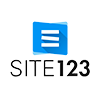






52 comments